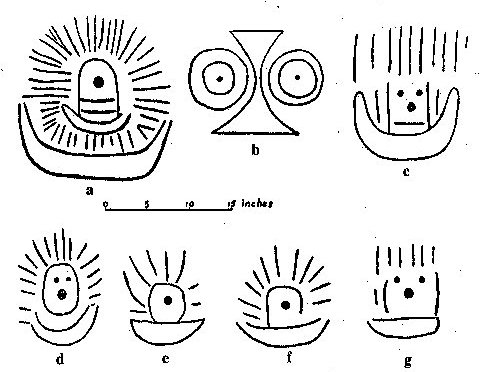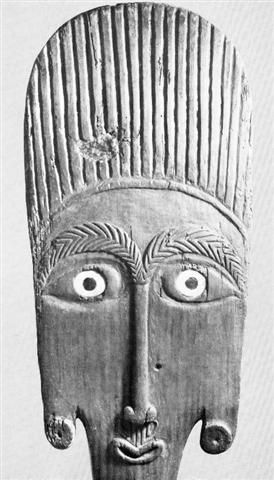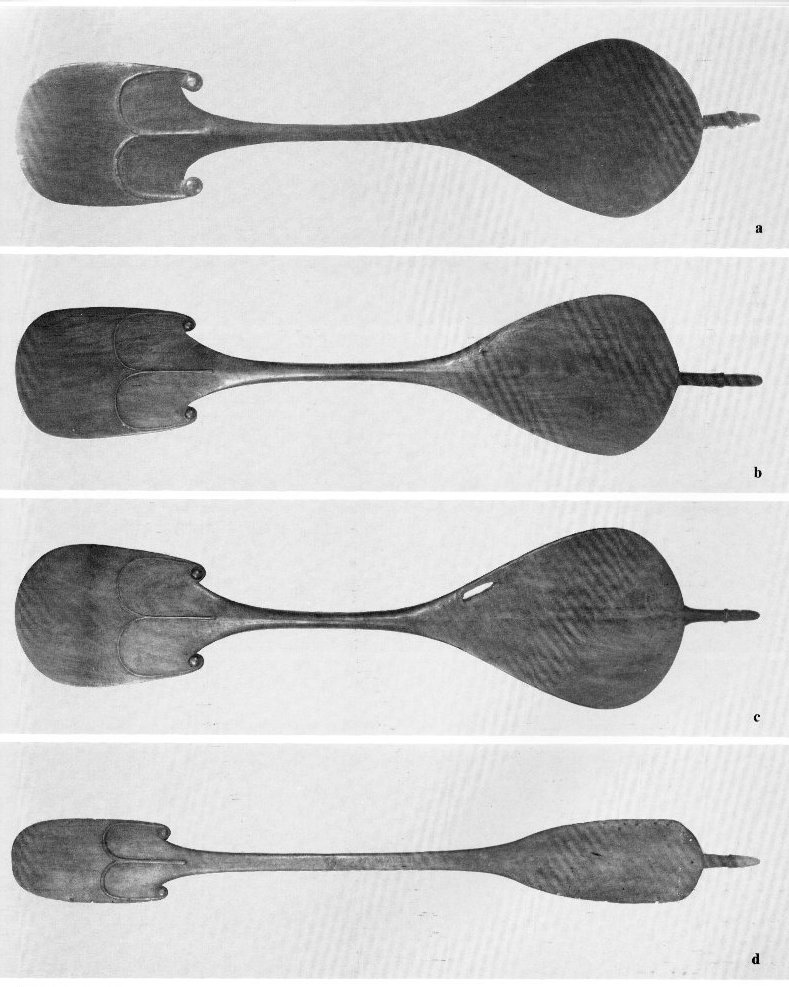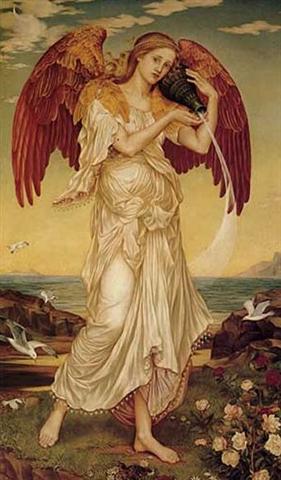2. Our problem
(how to accommodate in 'close
embrace' both the idea of a
solstice and the idea of a
quarter beyond solstice) gives me the
opportunity to - for the first
time here in Dream Voyager
- try to integrate more
fully the recent
findings with that which I once
wrote regarding the glyph types
(e.g. hau tea). The
following are pages copied from
the glyph type dictionary:
|
A few preliminary
remarks and
imaginations:
1.
The
beams of the sun
which enlighten our
world:

presumably form the
bottom part of the
hau tea glyph
type. This way of
illustrating - with
the rays depicted as
straight lines - is
the same as in the
petroglyphs below
(ref. Heyerdahl 3):

The
vertical sun rays
are also seen on the
upper part of an
example of ao:
:
'A
large portion of the
upper blade,
corresponding to the
broad and tall
forehead, is covered
by dense rows of
vertically painted
stripes that may
indicate hair
although in some
specimens they
definitely assume
the aspects of a
feather-crown of the
type common in
aboriginal Easter
Island.' (Heyerdahl
3) |
|
Ao, aŰ
Large dance
paddle.
1. Command,
power, mandate,
reign: tagata
ao, person
in power, in
command, ruler.
2. Dusk,
nightfall. 3.
Ao nui,
midnight. 4.
Ao popohaga,
the hours
between midnight
and dawn.
AŰ,
to serve (food);
ku-‚o-Š te
kai i ruga i te
kokohu, the
food is served
on a platter.
Vanaga.
1. Authority,
kingdom,
dignity,
government,
reign (aho);
topa kia ia
te ao,
reign;
hakatopa ki te
ao, to
confer rank;
ao ariki,
royalty; ka
tu tokoe aho,
thy kingdom
come. PS Mgv.:
ao,
government,
reign. Mq.:
ao,
government,
reign, command.
Sa.: ao,
a title of
chiefly dignity;
aoao,
excellent,
surpassing,
supreme. 2.
Spoon; ao
oone,
shovel. 3.
Dancing club T.
3. Aonui
(ao-nui
2), midnight. 4.
Pau.: ao,
the world. Mgv.:
ao, id.
Ta.: ao,
id. Mq.:
aomaama, id.
Ma.: ao,
id. 5. Pau.:
ao, happy,
prosperity.
Mgv.: ao,
tranquil
conscience. Ta.:
ao,
happiness. 6.
Mgv.: ao,
cloud, mist.
Ta.: ao,
id. Mq.: ao,
id. Sa.: ao,
cloud. Ma.:
ao, id. 7.
Mgv.: ao,
hibiscus. 8.
Ta.: ao,
day. Mq.: ao,
day from dawn to
dark. Sa.: ao,
id. Ma.: ao,
id. 9. Ta.:
ao, a bird.
Ha.: ao,
id. 10. Mq.:
ao,
respiration,
breath. Ha.:
aho, breath.
11. Mq.: ao,
to collect with
hand or net.
Sa.: ao,
to gather. Ma.:
ao, to
collect. Ta.:
aoaia, to
collect food and
other things
with care.
Churchill. |
|
'The ao
and rapa
differ from each
other mainly in
size and in
decoration, but
are otherwise
closely related.
Both were
double-bladed
paddles twirled
and shaken in
the hand during
ceremonial
dances. The
ao was the
larger of the
two types, with
a total length
that could
exceed 6 ft. (2
m.).
One blade of the
paddle, usually
pointing up
during dances,
has a
conventionalized
human face
carved and
painted on each
of its sides.
The blade itself
is carved flat
as on a
functional
paddle, with
almost parallel
edges and a
rounded distal
end.
The nose is very
long and
extremely
narrow, and
forks into two
prominent
eyebrows. This
curved, Y-shaped
combination of
nose and
eyebrows is
slightly raised
in relief. The
eyes are carved
and painted much
larger than the
mouth, which is
either reduced
to a minimum or
lacking. The
ears, however,
are invariably
present and
carved in a
conventionalized
manner as two
downward
projecting lobes
with circular
earplugs.

One very old and
worm-eaten
sample (Boston
64845) has fish
vertebrae
inserted as
earplugs. The
specimen,
collected by
Agassiz'
Albatross
Expedition as
late as 1904-5,
has doubtless
been kept hidden
in a cave. A
large portion of
the upper blade,
corresponding to
the broad and
tall forehead,
is covered by
dense rows of
vertically
painted stripes
that may
indicate hair
although in some
specimens they
definitely
assume the
aspects of a
feather-crown of
the type common
in aboriginal
Easter Island.
Some specimens
have vertical
tear marks
painted as
parallel stripes
running from the
bases of the
large eyes down
across the chin.
This
'weeping-eye'
motif is
particularly
pronounced on
the ancient
ao symbols
preserved as
mural paintings
on the slabs in
the ceremonial
houses of
Orongo
(Ferdon, 1961,
Figs. 65 b, f
and Pl. 29 c;
this vol., 183
a). Some faces
on ao
paddles are
painted with
geometric fields
suggesting
tattoo.

Only one
twin-faced blade
of the ao
is painted; the
rest of the
paddle is left
polished and
plain. A slim
handle with an
oval
cross-section
that becomes
almost circular
at mid-length
connects the
painted blade
with the other
one which is
undecorated. It
has the same
outline except
for the lack of
indentations
carved below the
earlobes of the
decorated blade.
In some
specimens the
second blade is
slightly
narrower and has
a rounded
rectanguloid
outline. A
fingerlike
projection with
a ring-shaped
band in relief
around its
midsection is
sometimes, but
not always,
carved at the
center of the
distal end of
this second
blade. In some
specimens the
ring is replaced
by a steplike
transition from
a wider upper
part to a
narrower lower
part. This
extension
corresponds to
the knob carved
elsewhere on
some functional
paddles and
serves for
pushing off or
staking
operations.'
(Heyerdahl 3) |
It should be added that the
beams announcing the arrival of the rising Sun
presumably were depicted in
Ha5-50. A comparison with the
parallel text sequence in
Tahua is useful:
 |
 |
 |
- |
- |
 |
|
Aa1-16 |
Aa1-17 |
Aa1-18 |
Aa1-19 |
|
ka ero |
ka
tapamea |
ma
te tagata e hetu
noho i te here |
i
uhi tapamea |
 |
 |
 |
 |
 |
 |
 |
|
Ha5-49 |
Ha5-50 (325) |
Ha5-51 |
Ha5-52 |
Ha5-53 |
Ha5-54 |
Ha5-55 |
In Ha5-50 we
can count 5 * 5(0) = 25(0)
as a sign of Saturn (who
ignites the Fire). And this is
glyph 325, a number equal to
13 * 25. It seems to denote
the beginning, for instance
in the tamaiti glyph
Ga7-11:
The
expression ka ero
used by Metoro at Aa1-16 can possibly
be explained as a word play
involving (among other
things) the negative of the
double eo-eo:
|
Eoeo
Ashes. Eoeo
reherehe 'weak
ashes': a coward.
Ure eoeo reherehe te
Mokomae, he poko'o i
te piko. The
Mokomae were a
cowardly clan, they
used to hand over
those hiding (from
their enemies after
a defeat, i.e. war
refugees). Vanaga. |

"In Greek
mythology, Ēōs ..
Ancient Greek:
Ήώς,
or
Έως,
…ōs,
'dawn' ... is a Titaness and
the goddess of the dawn, who
rose each morning from her
home at the edge of the
Oceanus.
Eos is
cognate to Vedic Sanskrit
Ushas and Latin
Aurora, both goddesses
of dawn, and all three
considered derivatives of a
PIE stem *Hzewsοs
(→ *Ausοs),
'dawn', a stem that also
gave rise to Proto-Germanic
*Austrō, Old Germanic
‘stara and Old
English Ēostre/Ēastre."
(Wikipedia)
|







